Kansai
Traditional Japan
Use the navigation bar on the left or the map-links to select a place. Alternatively scroll down to see all the entries. Click on photos to enlarge. See more Kansai photos here.
Kyoto
In November 2007 I took a week to travel around the Kansai area with one of my friends, who came to visit from the UK. We stared in Sapporo, then flew down to Tokyo, and continued on to Kyoto.
Kyoto is a large city, often dubbed as the cultural capital of Japan, and there are indeed many traditional building still standing throughout the city. On our first day we started in the station area, looking around the Shosei-en gardens, which are nicely sculpted with many bridges. The trip had been timed with that of the autumn leaves, so there were many splashes of colour against the cool blue sky.
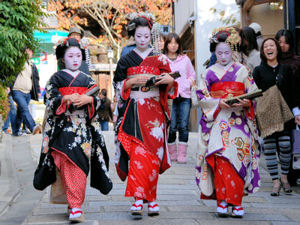 From Shosei-en we progressed on to the massive Higashi Hongan temple. Currently this temple is house within a massive warehouse as the whole thing is being carefully renovated, and this building dominates much of the mid Kyoto skyline. We could still look at some of the outer buildings, but it would be nice to return in a few years to see the finished renovation. Here we met a group of school kids let loose in Kyoto for a school trip under the strict order to talk to foreigners. After a brief interview we quizzed them on the best places in Kyoto and posed for the obligatory photos. Thinking we should probably get a second opinion we headed for the station for a quick lunch and a browse of the information kiosks before headed to the temple complex of Kiyomizu-dera. This is one of the most famous temple areas in Japan and was packed with temple goers and leaf viewers. The whole area contains many old houses and actually provides a glimpse of a more traditional Japan, including the odd sightings of Geisha, although the ones we saw were posing for photos so I'm not sure how real it all was. Following this we walked the old canal, aiming to reach the silver temple. Unfortunately everything closes around 5 so we had to miss this and instead head back into the town centre for some Yakitori.
From Shosei-en we progressed on to the massive Higashi Hongan temple. Currently this temple is house within a massive warehouse as the whole thing is being carefully renovated, and this building dominates much of the mid Kyoto skyline. We could still look at some of the outer buildings, but it would be nice to return in a few years to see the finished renovation. Here we met a group of school kids let loose in Kyoto for a school trip under the strict order to talk to foreigners. After a brief interview we quizzed them on the best places in Kyoto and posed for the obligatory photos. Thinking we should probably get a second opinion we headed for the station for a quick lunch and a browse of the information kiosks before headed to the temple complex of Kiyomizu-dera. This is one of the most famous temple areas in Japan and was packed with temple goers and leaf viewers. The whole area contains many old houses and actually provides a glimpse of a more traditional Japan, including the odd sightings of Geisha, although the ones we saw were posing for photos so I'm not sure how real it all was. Following this we walked the old canal, aiming to reach the silver temple. Unfortunately everything closes around 5 so we had to miss this and instead head back into the town centre for some Yakitori.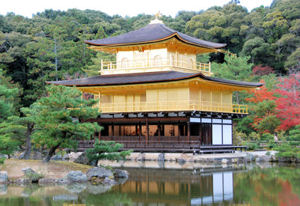 The second day we hired bikes to cover more ground and headed over to the fish market. Following this we headed up river to the Imperial palace. This is was nice enough although you can't see so much so we quickly continued on to Nijo-jo, an old merchant's home from the feudal times. Like most buildings in Japan it has been frequently levelled by fire and restored, so the actual age is hard to say, but the grounds are nice and the moat is well preserved. After lunching in a Ramen cafe we headed to Kinkaku-ji, or the golden temple, which is one of the great sights of Japan. This is situated a little way outside central Kyoto so was not as busy as Kiyomizu-dera, but had a fair drawing of crowds. It is a very picturesque location and being slightly in the hills also meant the trees were healthier and so had more beautiful red leaves. Just down the road is Ryoan-ji, a Zen rock garden where you sit and view the beauty of the patterns in the gravel. The idea is to do this until you can draw your own conclusions about the means of the rocks and swirls, although verifying the number of rock was a tough enough challenge that seemed to occupy most peoples time.
The second day we hired bikes to cover more ground and headed over to the fish market. Following this we headed up river to the Imperial palace. This is was nice enough although you can't see so much so we quickly continued on to Nijo-jo, an old merchant's home from the feudal times. Like most buildings in Japan it has been frequently levelled by fire and restored, so the actual age is hard to say, but the grounds are nice and the moat is well preserved. After lunching in a Ramen cafe we headed to Kinkaku-ji, or the golden temple, which is one of the great sights of Japan. This is situated a little way outside central Kyoto so was not as busy as Kiyomizu-dera, but had a fair drawing of crowds. It is a very picturesque location and being slightly in the hills also meant the trees were healthier and so had more beautiful red leaves. Just down the road is Ryoan-ji, a Zen rock garden where you sit and view the beauty of the patterns in the gravel. The idea is to do this until you can draw your own conclusions about the means of the rocks and swirls, although verifying the number of rock was a tough enough challenge that seemed to occupy most peoples time.
Shirahama
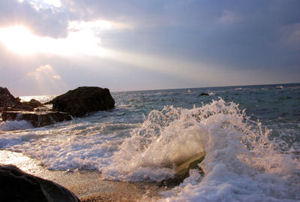 The next day we headed around the southern peninsula of Kii Hanto down to Shirahama. This required a lengthy train journey and so we arrived early afternoon. We took lunch at a small local restaurant which seemed to specialise in tuna and the owner reminisced about the biggest salmon he had ever seen when he visited Hokkaido. We took a bus down to the sea and then wandered around the cliffs. The lighting today was good with rays of the sun passing through the clouds, which is rare for Japan it seems. The main beach of the town was in fact washed away several years ago and so a new one from Australia has been installed - this is Japan after all. This region of Kansai is particularly famous for its hot springs, and here we took a bath in hot pools right on the edge of the breaking waves, which was quite an experience. After consulting the guide it seemed sensible to return all the way to Osaka that night and stay in a capsule hotel to allow a rapid start the next morning. Osaka has a vibrant evening scene and the hotel was situated right in the centre of an area of restaurant which all served very good food.
The next day we headed around the southern peninsula of Kii Hanto down to Shirahama. This required a lengthy train journey and so we arrived early afternoon. We took lunch at a small local restaurant which seemed to specialise in tuna and the owner reminisced about the biggest salmon he had ever seen when he visited Hokkaido. We took a bus down to the sea and then wandered around the cliffs. The lighting today was good with rays of the sun passing through the clouds, which is rare for Japan it seems. The main beach of the town was in fact washed away several years ago and so a new one from Australia has been installed - this is Japan after all. This region of Kansai is particularly famous for its hot springs, and here we took a bath in hot pools right on the edge of the breaking waves, which was quite an experience. After consulting the guide it seemed sensible to return all the way to Osaka that night and stay in a capsule hotel to allow a rapid start the next morning. Osaka has a vibrant evening scene and the hotel was situated right in the centre of an area of restaurant which all served very good food.
Osaka
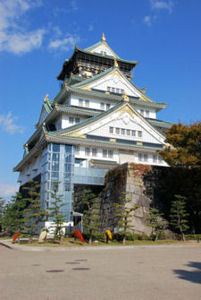
The following morning we had a brief look around Osaka. The first stop was the Umeda sky building, which towers over the skyline; the views from the top were excellent as again the weather was clear. From here we headed down to Osaka Castle. This is very famous as it was the base for Hideyoshi, a great fighter who went on to conquer much of Japan, and not only is the castle itself very grand but the museum inside is also excellent. Time was a little pressing today so we grabbed bento boxes for lunch and, after over an hour chasing around different stations, headed out towards the monastery town of Koya san, situated out in the surrounding mountains.
Koya San
 This journey required the change onto a special line to crawl up into the mountains, and then a second change onto a cable car for the final section. The sun was setting by the time we arrived (this occurs around 4:30 in November) so we could not see much of the town at this time. The main reason to visit Koya san is to stay in the special temple accommodation, sample the monk's cooking, and perhaps join a meditation class. The plan was to book in advance but I had been unable to find a working phone number so we trawled around a number of temple inns before coming to the conclusion that they were all 'ippai' - full. Fortunately the youth hostel was almost empty, and not only was it significantly cheaper than the temples, it was also situated in a very nice old building and the breakfast was of a similar style to that of a monastery I think. We spent the morning walking around the temples and grave areas where many of the famous Japanese monks are buried, then had lunch at a noodle restaurant before trawling back to Osaka. We again stayed in the same capsule hotel (which is the best I've stayed in) and went to an excellent Korean restaurant for a large nabe - nabe is my favourite food, especially in winter, a spicy hot pot of vegetables and meet.
This journey required the change onto a special line to crawl up into the mountains, and then a second change onto a cable car for the final section. The sun was setting by the time we arrived (this occurs around 4:30 in November) so we could not see much of the town at this time. The main reason to visit Koya san is to stay in the special temple accommodation, sample the monk's cooking, and perhaps join a meditation class. The plan was to book in advance but I had been unable to find a working phone number so we trawled around a number of temple inns before coming to the conclusion that they were all 'ippai' - full. Fortunately the youth hostel was almost empty, and not only was it significantly cheaper than the temples, it was also situated in a very nice old building and the breakfast was of a similar style to that of a monastery I think. We spent the morning walking around the temples and grave areas where many of the famous Japanese monks are buried, then had lunch at a noodle restaurant before trawling back to Osaka. We again stayed in the same capsule hotel (which is the best I've stayed in) and went to an excellent Korean restaurant for a large nabe - nabe is my favourite food, especially in winter, a spicy hot pot of vegetables and meet.
Nara
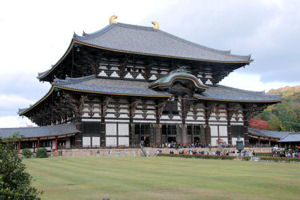 The next day we headed back out of Osaka for the 3rd time (the way the rail network is constructed makes it hard to do anything different), this time to the famous old capital of Nara. Nara is around 800 years old and, while many of the original buildings have been destroyed by fire, several temples date back hundreds of years and this is one of the first places in Japan I've been that really feels old. The most famous of the temples is Todai ji, which is said to be the largest wooden structure on earth. At Kasuga taisha you could get a fortune reading, and even had an English version (I have several Japanese ones but have no idea what they say, all good I assume). Mine starts 'Limited Good Fortune', but goes on to say my hopes will be fulfilled in time, and for a Brit that's pretty good.
The next day we headed back out of Osaka for the 3rd time (the way the rail network is constructed makes it hard to do anything different), this time to the famous old capital of Nara. Nara is around 800 years old and, while many of the original buildings have been destroyed by fire, several temples date back hundreds of years and this is one of the first places in Japan I've been that really feels old. The most famous of the temples is Todai ji, which is said to be the largest wooden structure on earth. At Kasuga taisha you could get a fortune reading, and even had an English version (I have several Japanese ones but have no idea what they say, all good I assume). Mine starts 'Limited Good Fortune', but goes on to say my hopes will be fulfilled in time, and for a Brit that's pretty good.After leaving Nara we continued back to Tokyo and visited the lakes to the north of Mt. Fuji
Nagoya
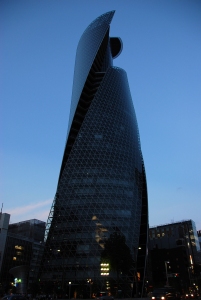 Nagoya is the in heart of the Japanese industrial zone and is not renowned for its sights. However it has a fine city centre and is a major transport hub so I stopped here on my 2008 final tour of Japan. Being August is was intensely hot and humid so things had to be done at a slower pace and sticking to air conditioned areas was a key activity. I gave myself two days here to catch up with correspondence and to plan my next steps into western Honshu and Kyushu, so had some time to look around.
Nagoya is the in heart of the Japanese industrial zone and is not renowned for its sights. However it has a fine city centre and is a major transport hub so I stopped here on my 2008 final tour of Japan. Being August is was intensely hot and humid so things had to be done at a slower pace and sticking to air conditioned areas was a key activity. I gave myself two days here to catch up with correspondence and to plan my next steps into western Honshu and Kyushu, so had some time to look around.
Before I have always passed through Nagoya on the railway, where very little of the city is really seen, however coming in by road we passed through what must be one of Japan's biggest and most opulent Love Hotel districts, with many reconstructed fairytale castles, Arabian castles etc, etc, all lit up in the fading dusk. The area around the station also has many large and stylish buildings of a more professional appearance and again I was able to find an excellent capsule hotel nearby.
There is little to really say about the sights of Nagoya and the temperatures did not really lend themselves to extensive activity. The Atsuta Jingu is set in a nice park and there is some attempt to turn the port into a tourist attraction, although this is quite limited. Like any city there are plenty of shops and modern buildings, and I'm sure it would be a great place to live (assuming you had excellent air conditioning).
Takayama
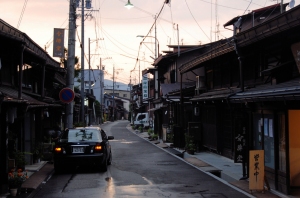 Takayama is an old style town hidden up in the mountains, and is a massive tourist attraction over the summer months as a place to retreat from the scorching heat of the lowlands. It was still very hot when I arrived late one afternoon, but the humidity was significantly lower, making walking both possible and enjoyable. Due to the massive popularity of the place it is very tourist orientated and over the summer holidays the hotels fill up quickly, I think I was lucky to find a reasonable place. Takayama's appeal is mostly that it has an old town area which escaped both bombing in the war and, more importantly, modernisation in the more recent industrialisation period. There are also many temples, and outside the town the land quickly turns to field and rice paddies making for nice walks. That evening some traditional music and dance was performed in the market area while some of the local farmers tried to sell their wares to the gathered tourists; I think this must have been aimed at the foreigners as there was more craft works stalls than food stalls, but the performances were nicely done.
Takayama is an old style town hidden up in the mountains, and is a massive tourist attraction over the summer months as a place to retreat from the scorching heat of the lowlands. It was still very hot when I arrived late one afternoon, but the humidity was significantly lower, making walking both possible and enjoyable. Due to the massive popularity of the place it is very tourist orientated and over the summer holidays the hotels fill up quickly, I think I was lucky to find a reasonable place. Takayama's appeal is mostly that it has an old town area which escaped both bombing in the war and, more importantly, modernisation in the more recent industrialisation period. There are also many temples, and outside the town the land quickly turns to field and rice paddies making for nice walks. That evening some traditional music and dance was performed in the market area while some of the local farmers tried to sell their wares to the gathered tourists; I think this must have been aimed at the foreigners as there was more craft works stalls than food stalls, but the performances were nicely done.
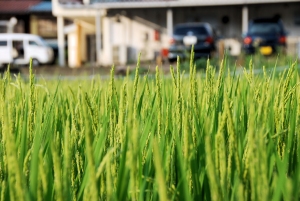
The following morning I hired a bike and headed out of town along the river for a bit of a look around, then visited the Merchant houses of the town, which are the main attractions in the guides due to their cultural importance and very high quality of maintenance. After an excellent lunch of Ramen I then caught a bus back to Nagoya.